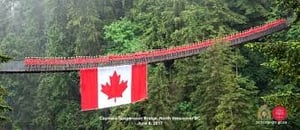 As I work to promote FRP for bridges through Composite Advantage (CA) sales and through the educational efforts of the American Composites Manufacturers Association’s (ACMA), I’ve observed an interesting phenomenon. FRP enjoys a stronger acceptance in Canada than in the U.S. Our primary sales efforts have tended to be local because there are so many opportunities where FRP could benefit the 610,000 bridges in the U.S. A company can only spread its resources so far especially when the work often calls for a hands-on approach. Our engineered solutions require frequent interaction with design engineers and contractors. I first noticed the uptick in Canadian interest when FRP rebar suppliers found more projects there and with much larger quantities. Bridge deck inquiries picked up as design engineers saw value in FRP’s benefits. I find that new technology has to be able to solve multiple problems to really gain acceptance; especially if there is a price premium. The Canadian decision makers wanted light weight for historic bridges; a solid surface to protect the superstructure underneath; and corrosion resistance for long life. With only 47,000 bridges, Canada has 8 percent of the North American bridge market. But Canada has more than 8 percent of our current activity.
As I work to promote FRP for bridges through Composite Advantage (CA) sales and through the educational efforts of the American Composites Manufacturers Association’s (ACMA), I’ve observed an interesting phenomenon. FRP enjoys a stronger acceptance in Canada than in the U.S. Our primary sales efforts have tended to be local because there are so many opportunities where FRP could benefit the 610,000 bridges in the U.S. A company can only spread its resources so far especially when the work often calls for a hands-on approach. Our engineered solutions require frequent interaction with design engineers and contractors. I first noticed the uptick in Canadian interest when FRP rebar suppliers found more projects there and with much larger quantities. Bridge deck inquiries picked up as design engineers saw value in FRP’s benefits. I find that new technology has to be able to solve multiple problems to really gain acceptance; especially if there is a price premium. The Canadian decision makers wanted light weight for historic bridges; a solid surface to protect the superstructure underneath; and corrosion resistance for long life. With only 47,000 bridges, Canada has 8 percent of the North American bridge market. But Canada has more than 8 percent of our current activity.

Grand Opening of the Blackfriars Bridge in London, Ontario
The reasons for this are ones that I see in other industries and societal trends. There is more emphasis on longer term solutions; even if the initial cost is higher. Higher snow fall totals and greater use of ice melting chemicals has put a higher value on corrosion resistance and a solid surface compared to steel grid decking. Seeing the piles of chemical-laced snow on the superstructure and mechanisms of a movable bridge emphasized the toll that the environment puts on these bridges. I also cite comfort level as a reason for increasing interest. The FRP decking product we supply today reflects lessons learned over the past 20 years of technology development. The products are much more polished with standard details that have been proven in the field. In the U.S., there are still many states and agencies that don’t have a comfort level with FRP bridge elements. Some of these states were involved with FRP when it was just starting through projects like the Innovative Bridge Research Construction (IBRC) initiative. Being innovative, there were unforeseen issues that led to improvements. Unfortunately, some of the issues that arose during these projects gave early adopters [owners and designers] pause. . Today’s adopters are benefitting from FRP’s evolutionary progress; including many in Canada.

